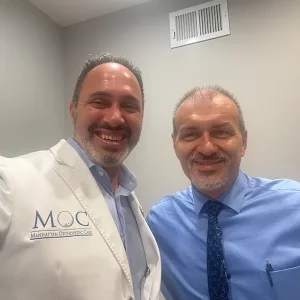Frozen Shoulder: How to recognize this uncomfortable shoulder condition?
The shoulder is the only joint in the body that can freeze up and stop functioning, which is a surprising fact that nobody seems to understand fully.
Frozen shoulder, medically known as Adhesive capsulitis, is a painful shoulder condition that limits the range of motion. It can occur mysteriously, out of nowhere, or it can be a result of some other health condition or disease such as diabetes. The frozen shoulder can also occur after a trauma to shoulder, such as a direct fall on it, and it can also follow a long period of immobilization. Regardless of the cause, the symptoms always remain the same: pain that causes discomfort and increases over time and stiffness that makes the movement difficult or impossible. The pain typically originates in the shoulder joint, and without treatment, it spreads to the muscles that wrap the top of the arm.How to recognize the frozen shoulder?
This shoulder conditions an extremely common one, yet it’s still hard to diagnose it correctly and treat it adequately. Frozen shoulder tends to pull the rounded head of the humerus (upper arm bone) further into its socket. Therefore, orthopedic professionals consider the nature of the frozen shoulder as a biological glitch, or simply, a mechanical breakdown. While orthopedic professionals haven’t reached common ground on the reasons why the shoulder freezes, numerous health experts link the frozen shoulder to underlying health conditions. Still, the signs of frozen shoulder occur moderately, and they slowly worsen over time. The frozen shoulder has three stages, and they all have specific symptoms and a timeline. Freezing stage
In the freezing stage, symptoms start to develop slowly. The pain occurs in the shoulder and is consistent while moving the arm. Over time, the pain becomes more intense, and for most patients, the pain level especially increases during night time. Moreover, shoulder movements become limited, and often, in this stage, patients can barely lift their arm. Typically, the freezing stage can last up to 9 months, even longer in more severe cases.
Frozen stage
In the second phase, the stiffness becomes a leading symptom. The pain slowly begins to subside. However, moving the arm is more complicated than in the freezing stage. As the movement becomes more difficult, it gets harder to go through everyday activities. During the frozen phase, patients may experience specific lifestyle changes. For most patients, this phase lasts somewhere between four and twelve months.
Freezing stage
In the freezing stage, symptoms start to develop slowly. The pain occurs in the shoulder and is consistent while moving the arm. Over time, the pain becomes more intense, and for most patients, the pain level especially increases during night time. Moreover, shoulder movements become limited, and often, in this stage, patients can barely lift their arm. Typically, the freezing stage can last up to 9 months, even longer in more severe cases.
Frozen stage
In the second phase, the stiffness becomes a leading symptom. The pain slowly begins to subside. However, moving the arm is more complicated than in the freezing stage. As the movement becomes more difficult, it gets harder to go through everyday activities. During the frozen phase, patients may experience specific lifestyle changes. For most patients, this phase lasts somewhere between four and twelve months.
 Softening stage
During the third and last phase, the stiffness slowly subsides, and the shoulder gains back its mobility. This phase can last up to two years, depending on the severity of the condition.
Softening stage
During the third and last phase, the stiffness slowly subsides, and the shoulder gains back its mobility. This phase can last up to two years, depending on the severity of the condition.
How to tell if the shoulder is frozen?
There is still no one typical test performed to diagnose and confirm the frozen shoulder. Orthopedic doctors usually observe the shoulder range of motions. Furthermore, they also take into consideration the overall health of the patient and check for any underlying health condition.“If the shoulder feels “stuck” where it is very difficult to bring it behind your back, and you have a history of diabetes or thyroid disease, you might have a frozen shoulder,” says Dr. Armin Tehrany, one of the top New York shoulder doctors.Following are a few simple steps that can reveal a frozen shoulder:
- Lifting the arms overhead – if this movement is painful and the highest point the arm goes is being parallel to the floor, then most likely, the patient suffers a frozen shoulder. Additionally, at this point, the shoulder blade will rise unnaturally, and the pain will start moving towards the ear.
- Lifting the arms to the side – if the arm goes up to the point that is just level with the floor, and if it is painful, then the patient may have a frozen shoulder.
- Rotating the arms with bent elbows – if the patient feels pain while rotating the arms out with elbows bent at 90 degrees and tucked into the side, then the patient has a frozen shoulder.
Treatment of frozen shoulder
In most patients, the treatment of frozen shoulder includes medications to alleviate and control the pain, and preserving the range of motions in the shoulder. Furthermore, exercises provided by a physical therapist can immensely help the joint to recover better and sooner. While most patients with frozen shoulder recover in 12 to 18 months, severe cases with resistant symptoms may require a treatment that may even include surgery. Steroid injections are very effective in the early stages of the frozen shoulder. They help the shoulder as they decrease pain and improve shoulder mobility. Another solution is joint distension. By injecting sterile water into the joint capsule, the shoulder joint becomes able to stretch, thus makes it easier to move the joint.
In the later stages, when the shoulder is stiff and immobile, shoulder manipulation may help the patient. In shoulder manipulation, the surgeon moves and rotates the arm in different directions to help loosen the tightened tissue. To make the treatment bearable, the orthopedic surgeons usually perform the manipulation under general anesthesia.
Even though surgery for frozen shoulder is rare, in complex cases where no other treatment worked, the doctor may recommend surgery. The goal of the surgery is to remove scar tissue and adhesions from inside the shoulder joint. Typically, the surgery is arthroscopic, and patients experience a smooth and speedy recovery.
Another solution is joint distension. By injecting sterile water into the joint capsule, the shoulder joint becomes able to stretch, thus makes it easier to move the joint.
In the later stages, when the shoulder is stiff and immobile, shoulder manipulation may help the patient. In shoulder manipulation, the surgeon moves and rotates the arm in different directions to help loosen the tightened tissue. To make the treatment bearable, the orthopedic surgeons usually perform the manipulation under general anesthesia.
Even though surgery for frozen shoulder is rare, in complex cases where no other treatment worked, the doctor may recommend surgery. The goal of the surgery is to remove scar tissue and adhesions from inside the shoulder joint. Typically, the surgery is arthroscopic, and patients experience a smooth and speedy recovery. 





























